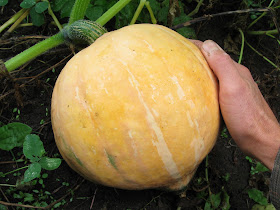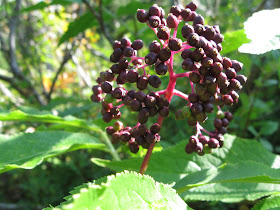 On a whim, we grew a couple Morelle de Balbis also known as a Litchi tomato this year with great success. The hardest part was getting the darn seeds to germinate, but once a few finally developed into little seedlings they quickly went on to grow into six foot tall thorny giants.
On a whim, we grew a couple Morelle de Balbis also known as a Litchi tomato this year with great success. The hardest part was getting the darn seeds to germinate, but once a few finally developed into little seedlings they quickly went on to grow into six foot tall thorny giants.
In Early July, after flowering, the fruit slowly started to develop. I was a bit unnerved when a few of the leaves started falling off until I finally realized they were shedding their leaves as new growth emerged...at least I assume that is what was going on. It would seem that there is very little information available on this plant. So far I have collected about a quart of fruit off each of the plants, not a lot but more then I had expected. The fruit really does taste like a cross between a cherry and a watermelon but is a bit on the seedy side.
Right now they are loaded with still maturing fruit, but with frost close at hand I have little faith that it will ever fully develop. Will I grow this extremely thorny plant again? Yes! But only a couple plants as they do take up a lot of room and really do not produce all that much in our short growing season. I will also NOT grow it so close to our garden gate as both of us are in danger of developing bald spots from ducking under some of the thorny branches. Who knows maybe someone will decide this is the next "superfood" and I can sell the seeds for $1.00 a piece.:)
The thorns are pretty nasty, Brer Rabbit would feel right at home in a patch of Litchi.

Picking this fruit without a pair of clippers is not all that pleasant...I learned this the hard way.

Even the husks have thorns, what a fascinating plant this turned out to be.

From a prior post, New Acquaintances In The Garden - Litchi Tomato aka Sticky Nightshade (S. sisymbriifolium)- A large plant that can grow around 5' tall and is covered in thorns. The prickly husk covered fruit is the size of a cherry tomato and supposedly tastes like a cross between a tomato, tart cherry, and watermelon. This "Wild Tomato" can be grown as you would any tomato but may not be a very prolific producer, nonetheless it certainly piqued my interest.
October 11 2009 Update-
It would appear that the litchi plant is also very hardy, ours has now easily survived five 29-31° nights and three nights of below 20° weather. The coldest weather caused the remaining fruits to become mushy but the plant itself still looks great.

 All endive seeds are tightly encased, and quite difficult to remove in large amounts
All endive seeds are tightly encased, and quite difficult to remove in large amounts Pounding the dry endive stalks with a rake in order to separate the seeds from their housing
Pounding the dry endive stalks with a rake in order to separate the seeds from their housing Straining the smaller chaff and seed from the larger debris
Straining the smaller chaff and seed from the larger debris

 Our overwintered celery began flowering in late June and a few are still blooming
Our overwintered celery began flowering in late June and a few are still blooming Once dry, the seeds will easily fall off the plant if not carefully removed every few days
Once dry, the seeds will easily fall off the plant if not carefully removed every few days




























 Besides all the huckleberries we also found
Besides all the huckleberries we also found 



 My wife picking up after the thoughtless slobs that last occupied this area
My wife picking up after the thoughtless slobs that last occupied this area
